Canon EOS Rebel T6 vs T7
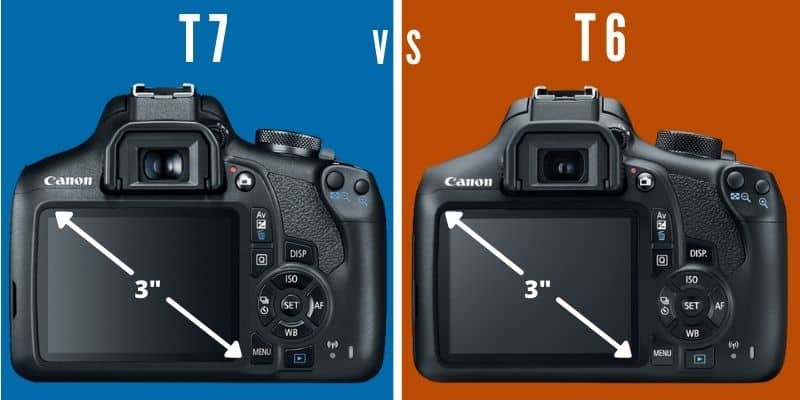
DSLR cameras are an investment, that’s for sure. You’ll find every beginner asking the same thing: “Which DSLR should I get?”
From the numerous brands I’ve tried, I definitely recommend Canon for all-around success. Its top-grade reputation won’t let you down.
Join me as I compare two DSLR cameras from the EOS Rebel Series by Canon. They’ve been world favorites for some time.
The Canon EOS Rebel T6 and the newer EOS Rebel T7 are both entry-level cameras unveiled in 2016 & 2018 respectively, and they share many similarities.
When comparing Canon EOS Rebel T6 Vs T7, T7 is preferable since it has more features and abilities, like higher sensor resolution, color depth, and dynamic range. It is also $100 cheaper, which is a plus for beginners.
Still, you definitely want to understand your options before making such a big purchase. But first, a little background.
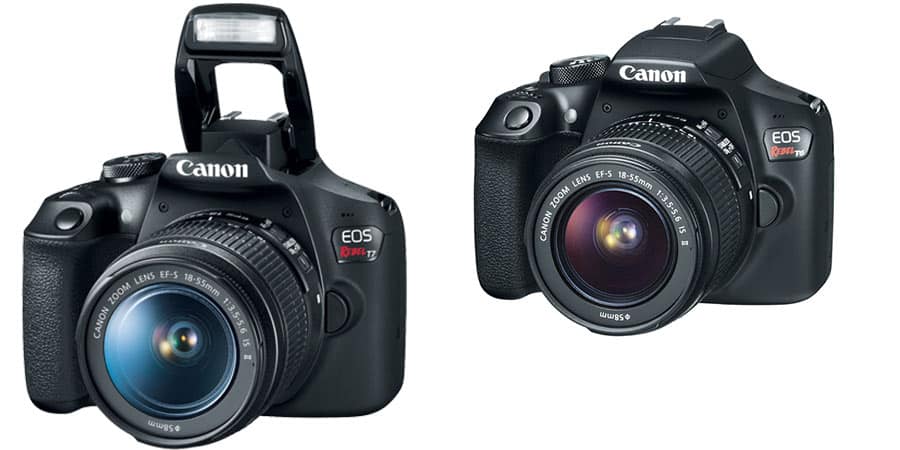
Table of Contents
Canon Rebel T6 vs. T7- A Quick Review
The Canon EOS Rebel T6 and the Canon EOS Rebel T7 are both APS-C sensors (Advanced Photo System type-C cameras) that are affordable and user-friendly.
In 2003, Canon launched a series of EOS Digital Rebel cameras. These were embedded with the APS-C system and were well received by the DSLR fans, since it helped them capture quality photos.
But the launching of EOS Rebel T6 really excited aspiring professionals. It had all the advanced shooting and sensor technology found in the digital cameras, and at a much lower starting price.
I think I speak for all of us when I say that we trust Canon as one of the pioneers of DSLR cameras. So when the T6 model was created, it was a no-brainer for many photographers. They especially loved its compatibility with a large range of lenses. The company then further improved the model in the EOS Rebel T7 camera.
Basic Specifications- Canon Rebel T6 vs. T7
Here’s the basic rundown. Notice that there’s just a bit of highlighted information, which indicates a difference between the models.
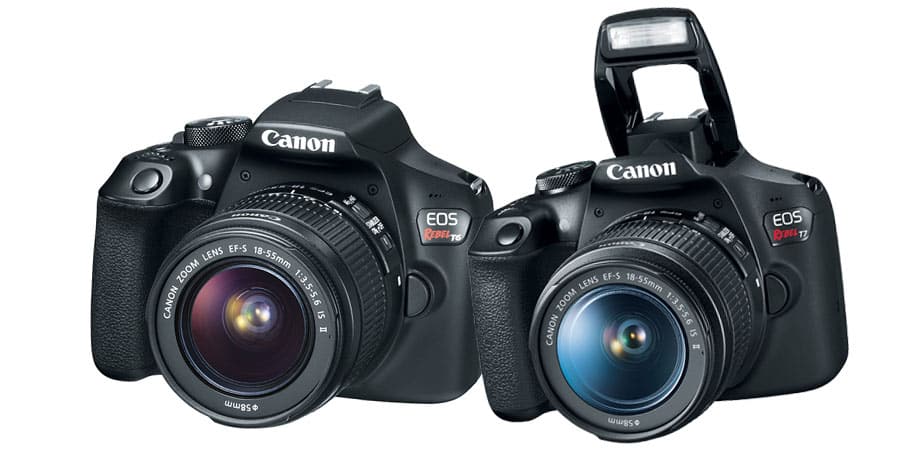
| Canon T6 | Canon T7 |
|---|---|
| Release Year: 2016 | Release Year: 2018 |
| ISO Setting: 100 – 6,400- Expandable – 12,800 | ISO Setting: 100 – 6,400- Expandable -12,800 |
| Canon EF/EF-S Mount Lenses | Canon EF/EF-S Mount Lenses |
| LCD: 3-inch Fixed- No Touch | LCD: 3-inch Fixed- No Touch |
| Weight: 485g | Weight: 475g |
| 129 x 101 x 78 mm | 129 x 101 x 78 mm |
| 500 shots per battery charge | 500 shots per battery charge |
| Video Resolution: 1920 x 1080 | Video Resolution: 1920 x 1080 |
| Viewfinder Type: Optical | Viewfinder Type: Optical |
| Pixel Pitch 4.31 μm | Pixel Pitch 3.72 μm |
| Pixel Density 5.39 MP/cm | Pixel Density 7.22 MP/cm |
| Hot Shoe Mount Present | Hot Shoe Mount Present |
| LCD Resolution: 307k pixels | LCD Resolution: 307k pixels |
| RAW Support | RAW Support |
| Flash Included | Flash Included |
| 3-inch LCD | 3-inch LCD |
| CMOS Sensor Technology | CMOS Sensor Technology |
| Crop Factor: 1.6x | Crop Factor: 1.6x |
| Storage: SDXC memory cards/ single slot | Storage: SDXC memory cards/ single slot |
| Continuous Shooting: 3fps | Continuous Shooting: 3fps |
| LP- E10 Battery Type | LP- E10 Battery Type |
| HDMI Output | HDMI Output |
Our Pick: Canon T7
Canon T7 Advantages Over T6:
- Newer Release- Advanced Technology- More Features
- Less Expensive ( $449 v/s $549)
- Almost Every Feature of T6 Included
- Better Photos Due To Higher Sensor Resolution ( 24MP vs. 18 MP)
- Better Burst Mode Due To Larger JPEG Buffer ( 150 vs. 15 Shots)
- Bigger Raw Buffer ( 11shots vs. six shot)
- Higher Color Depth and Dynamic Range
- Use As A Webcam
- Enhanced ISO performance.
- 10g Lighter

Canon Rebel T6 vs. T7- Feature Comparison
Body Comparison- Size & Weight:
We may all have different photography needs, goals, and styles. But one thing we photographers all agree on is that when it comes to our cameras, the lighter, the better.
Nobody appreciates a bulky or heavy camera, and this Canon series will not disappoint you.
The T6 model has a small and compact body dimension. Its lightness, low profile design, and manageable size make it easy to carry around. It can even be paired with a lens while remaining lightweight enough for any adventure!
The T6 and T7 are similar in size, weight, and dimensions. The only difference is that the T7 is 10g lighter, but you would barely feel such a small difference.
A camera’s lens really impacts its weight and feel, but the two models have an identical sensor (APS-C) and lens mount – no contrast there.
So practically, they’re pretty identical, though the T7 would win on the manual.

JPEG Buffer:
What is JPEG Buffer?
Your camera’s buffer is the place where your photos go before being uploaded to a memory card. This means that you can take more pictures as long as there’s room.
Once the buffer fills up and runs out of space, your camera will stop shooting and save it on your memory card!
The Canon EOS T7 has an ultra-large JPEG buffer, which can store 150 images before it would pause. Besides, it also possesses a bigger RAW buffer: 11 shots!
If you look at the T6 the JPEG buffer has only 15 shots! That means the t7 has 10 times the amount of space! For the RAW buffer, it is can handle six shots.
So clearly, Canon EOS T7 is the clear winner here. However, most people would not need more than 15 images on their jpeg buffer.
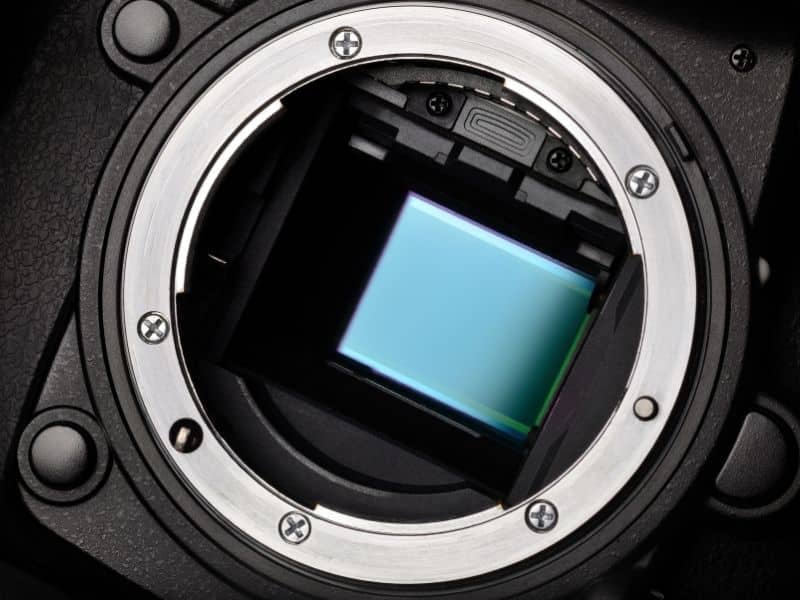
Sensor:
Sensor size is an important key.
Here’s the deal: A camera with a larger sensor will generally have better low-light sensitivity and offer a richer and broader range. On the downside, it would be bigger and more expensive.
- Canon T6 has an 18 MP (22 x 14mm) sized sensor and a Digic4+ processor.
- Canon T7 has a 24 MP (22.3 x 14.9 mm) sized sensor, and also a Digic 4+ processor.
So both have a sensor of similar, medium size. This means that when users set an equivalent focal length and aperture, both cameras yield an equal depth of field.
The medium-sized sensors make the cameras portable and provide a decent image quality.
Notice that the Canon T7 camera does have 6 MP more than the T6. This gives you a better range of options, including cropping images with less loss in quality.
You may have noticed that the one seeming advantage of the Canon T6 is that it has a 33% larger pixel area than the Canon T7, making it better for low light and high ISO images.
But because T7 was released a couple of years later, the sensor technology evolved during that time-space, and it actually produces better images than the T6.
Lens Compatibility:
One important decision to make before choosing an interchangeable lens camera is the number of lenses available. For example, Canons Rebel T7 and T6 are both Canon EF/EF-S mount with 326 native lenses.
However, both these cameras don’t offer sensor stabilization. Thus, you have to opt for a lens with optical stabilization.
This limits the number of lens choices. Currently, there are 112 lenses for the Rebel T6 and T7.

Video Features:
Both can capture still images and video footage and is great for those looking to have the best of both worlds. Canon EOS Rebel T6 & T7 offers an awesome 1920×1080 max resolution you won’t miss any detail in your videos!
They both come with ample sensor read-out speed which allows them to shoot moving pictures. They even boast H.264 or MPEG4 formats, while both have no microphone or headphone port.
In short, when tested, the video quality of both cameras. The T6 and the T7 were equally good due to the stark similarity between the specs.
If you want to test the quality yourself, you can throw a video from each into a professional tool or a cloud-based version like InVideo.
The phase detection autofocus feature is only available in the Canon T7 model. This ensures clearer footage that involves a lot of fast movements.
On the other hand, Canon EOS T6 has cinema mode, which is best for creating a film-like or artistic video.
Unfortunately, both these cameras are unable to capture slow-motion videos.

Connectivity:
Canon cameras allow you to wirelessly connect with your phone or tablet to share photos quickly and easily. The Canon Rebel T6 & Canon Rebel T7 comes equipped with wireless connectivity.
There were some glitches but it’s rarely reported. Overall they both have great wireless connectivity.
Luckily for beginner photographers who prefer simplicity over features, both the T7 and T6 come standard with WiFi/NFC. Making them perfect if exporting data on the go witch is important!
Both T6 and T7 cameras have embedded WiFi connections that allow them to connect wirelessly. They also have a mini HDMI port, so viewing pictures on TVs becomes more convenient!
In addition, data transfer through USB 2.0 is also possible on digital devices with a USB port.
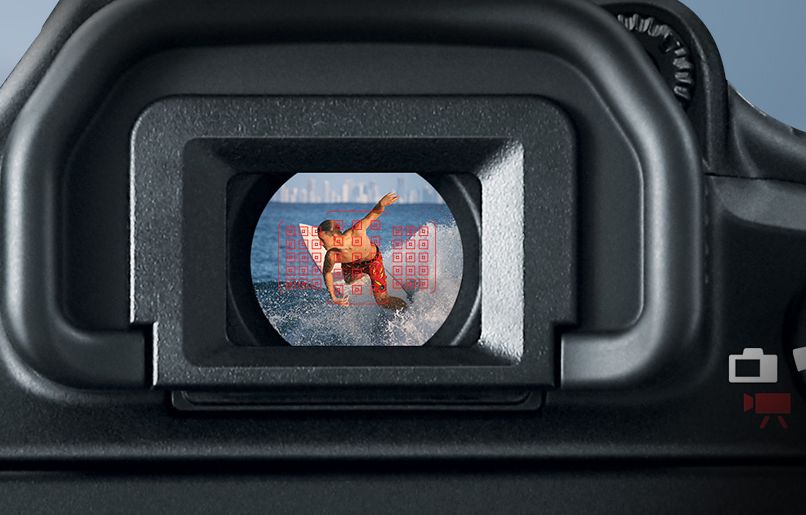
Viewfinder:
Optical viewfinders have been around for a long time. They are still popular because they provide great clarity and dynamic range, and instant picture-taking capabilities. Therefore most DSLR cameras come with optical viewfinders.
The T6 and the T7 are similarly equipped with an optical viewfinder that captures your subject in an accurate, stable way.
Also, both offer a view of the field of 95% as well as magnification for both cameras at 0.50x. This leaves you to know that your shots will be sharp each time.
Battery Life:
Battery life supplies are a huge factor when considering purchasing any camera. The Canon EOS Rebel T6 and the Canon Canon EOS Rebel T6, both have removable batteries that are rechargeable. Also, both have a fantastic and accurate battery level indicator!
If you are comparing Canon EOS Rebel T6 vs. T7, there is not much difference in this category as both will last Up to 500 shots per battery.
LCD:
The T6 and T7 cameras have a high resolution of 92000 dots 3inch TFT panel screen. however, a whopping 67% of cameras have a screen with the same quality as these two!
Canon T7 and Canon T6’s LCD screens have the same diagonal size of 3.”
They both have a 3-inch fixed panel. This means that you can’t tilt or flip them in different directions. Be sure to keep this in mind when choosing your camera.
Also, keep in mind that both of these cameras don’t have a touch screen.
Missing Features:
- Built-in Stabilization
- Weather Sealing
- Touch Screen
- In-Camera Panoramas
- Flexible Screen
- Bluetooth
- GPS
- On- Sensor Phase Detection
- Headphones & Mic Input
- Brighter Pentaprism Viewfinder
- Many Card Slots.
- Slow Motion Videos
Our Pick:
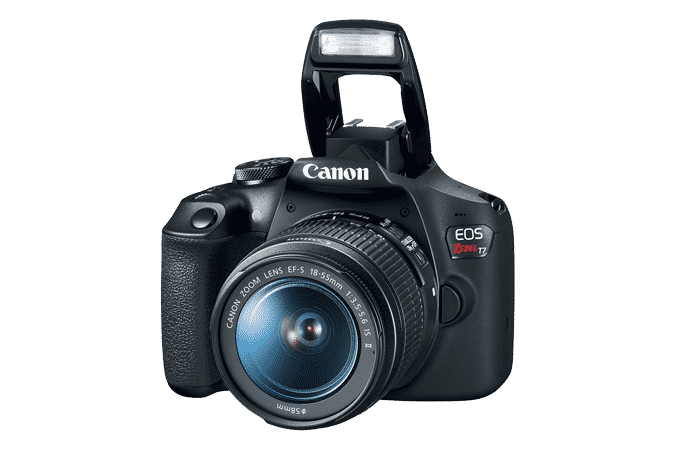
Our Pick: Canon T7
Canon T6 & T7 are both famous budget-friendly cameras; however, no principal factors make one camera more desirable. Moreover, both have almost identical specs and features, so it is tough to decide between a Canon T6 and T7 for newcomers. However, if you find yourself on this page, then we can help!
The Canon T7 is definitely a better camera than the T6 with some of its more powerful specifications and has all the features and specs of the Canon T6.
It’s improved…
- JPEG
- RAW buffers
- Higher sensor resolution
- Color depth, and
- Dynamic range
…all produce an even more satisfying outcome for budding photographers. The T7 is priced $100 lower than the T6 model, although the T6 is an older model. You can also use it as a webcam, and it’s 10g lighter, too, making it a way better choice overall.

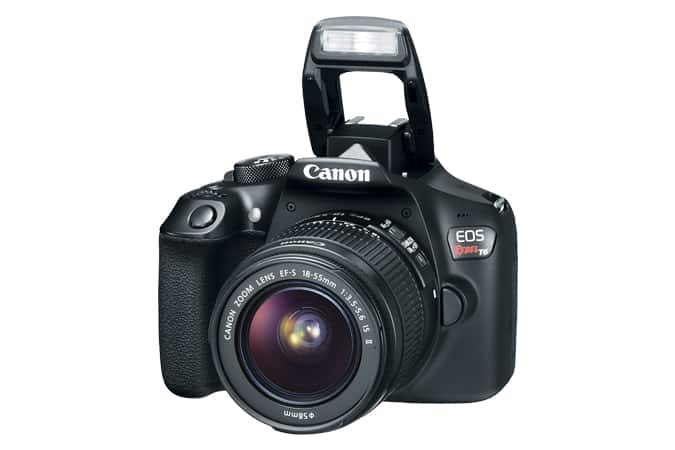
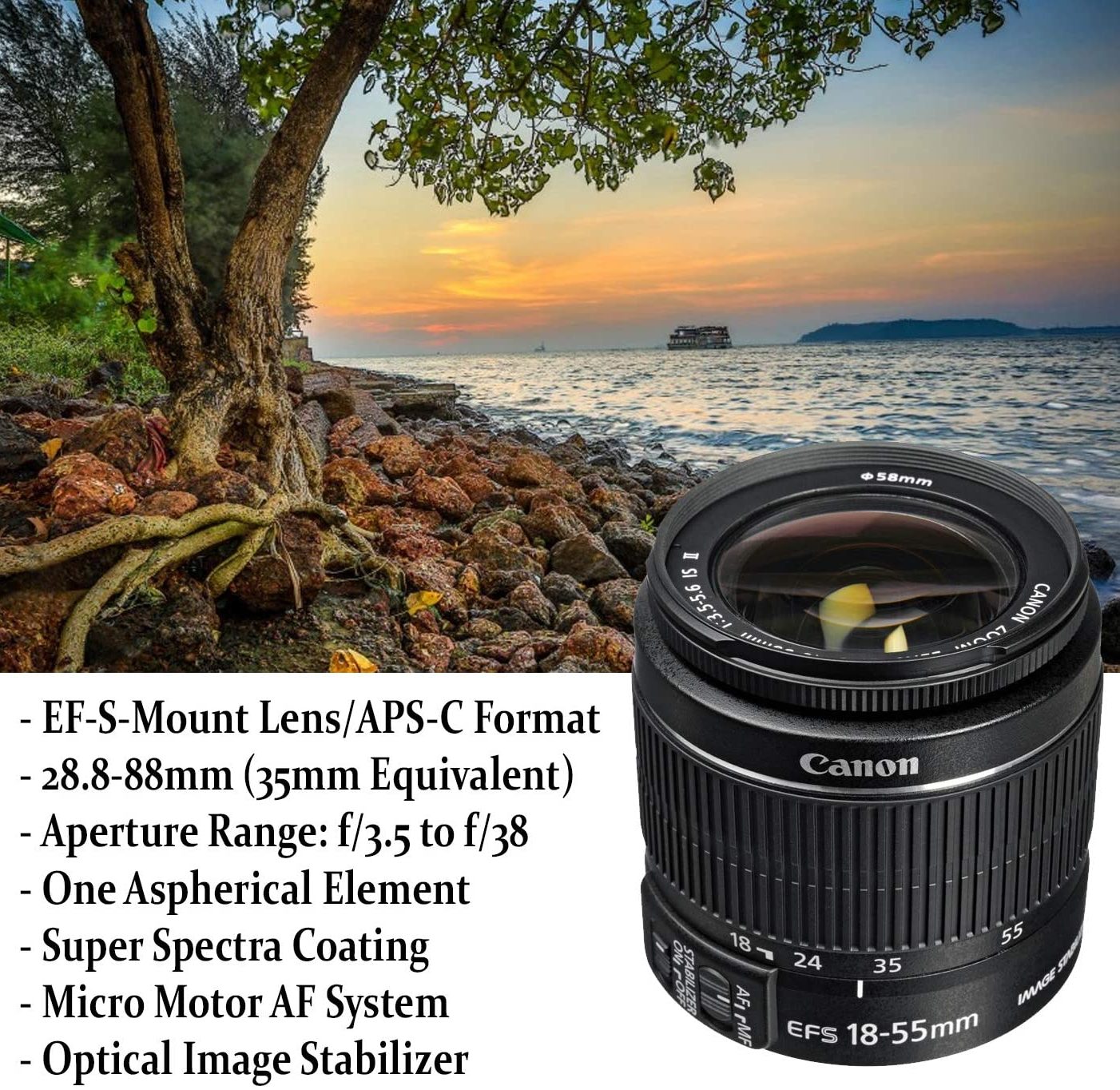
Thank you for all the educational information. It was helpful. I am looking to get a camera and have picked the T7 Canon. I will enjoy it.